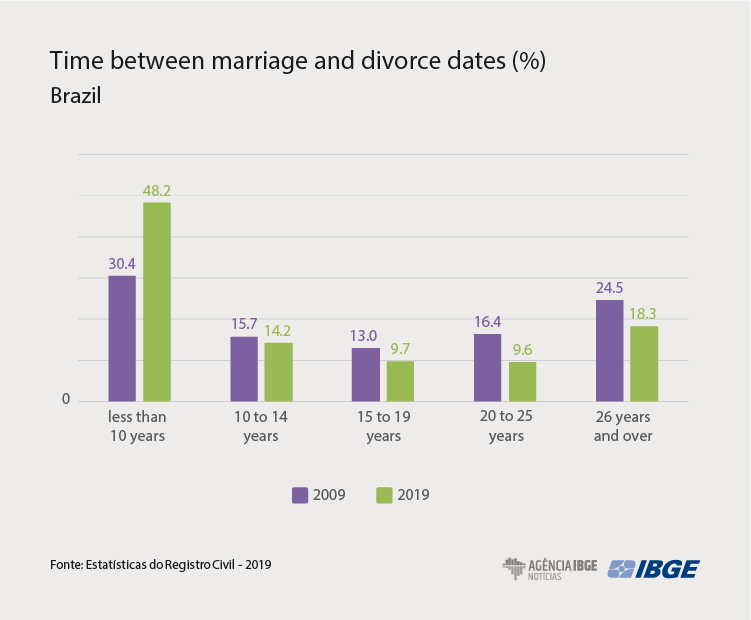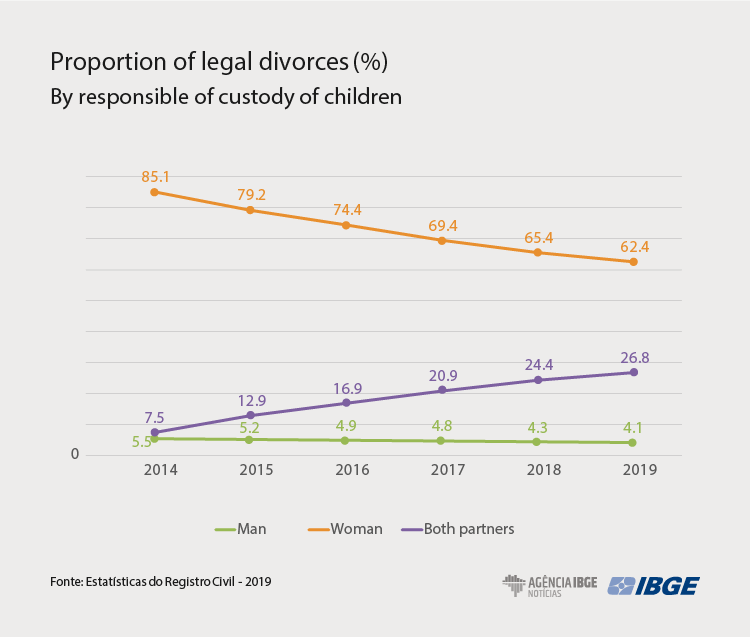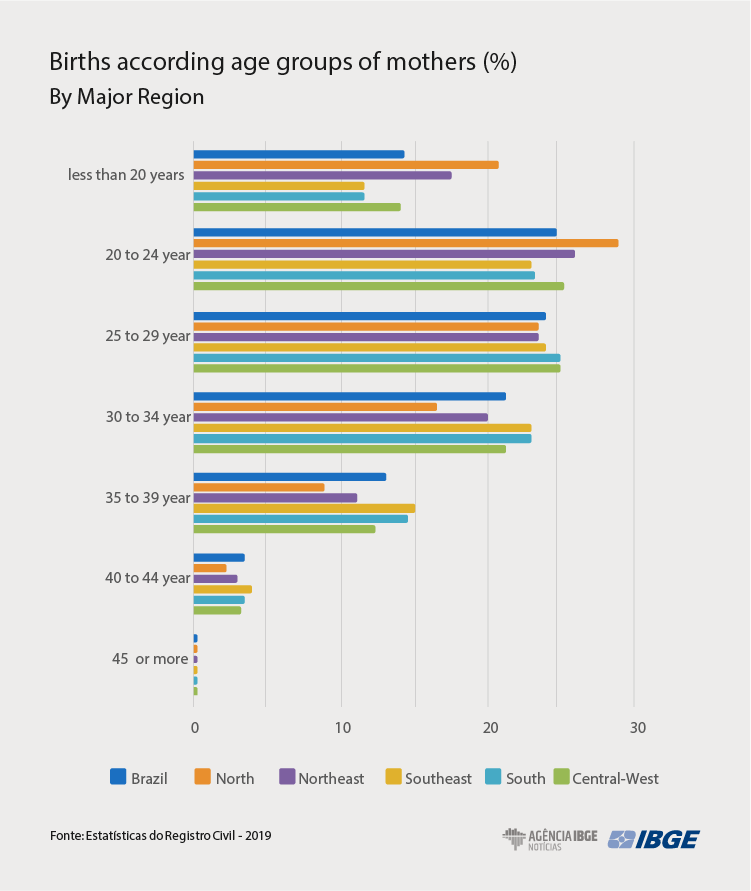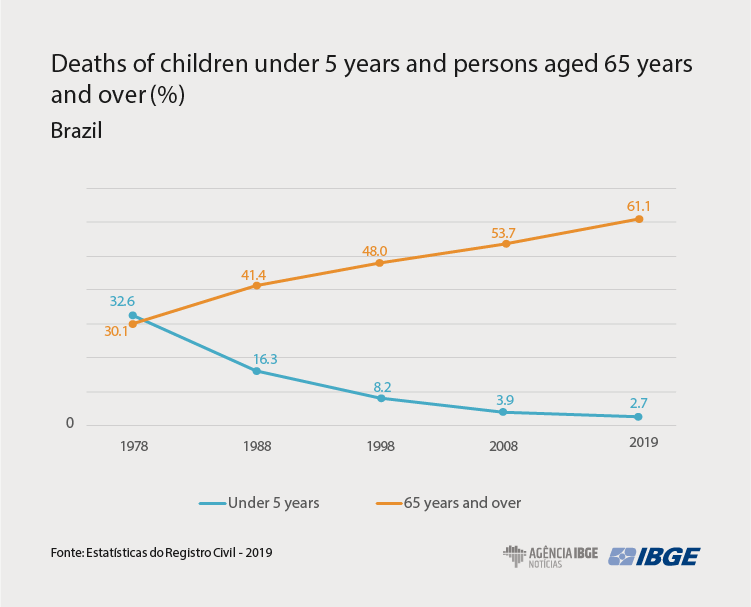Vital Statistics
Marriages reduce for fourth consecutive year, last shorter
December 09, 2020 10h00 AM | Last Updated: December 14, 2020 03h14 PM
Highlights
- Average length of marriages fell from 17.5 years to 13.8 years in ten years.
- The difference of average ages between partners was of 3 years, being that men married, on average, with 31 years and women, with 28 years of age.
- Shared custody grows from 7.5% to 26.8% since the law that prioritized this arrangement in 2014.
- Nearly 77,495 children were born and did not get their birth certificates in 2018.
- Between 1999 and 2019, the percentage of births whose mothers were aged up to 20 years fell from 21.4% to 14.3%, whereas those whose mothers were aged between 30 and 34 years increased from 14.9% to 21.1%.
- In 1978, the number of death registrations of persons aged 65 years and over represented 30.1% of the total; in 2019, this percentage hit 61.1%.
- The study pointed out a growth in death registrations of male youngsters aged between 15 and 24 years by external causes in most states of the North and Northeast.
- In 2018, of the total causes of death from falls for both sexes, 45.7% were among the population aged 80 years and over.

The number of civil marriages dropped in 2019 for the fourth year in a row. The records added up to 1,024,676, which represents a drop of 2.7% in the number of certificates. Marriages between same-sex persons reduced even more, -4.9%, with 9,056 civil unions. Since 2009, the average length of marriages dropped nearly 4 years. This information is part of the 46th edition of Vital Statistics, released today (9) by the IBGE. It also brings information on divorces, births and deaths from more than 20,000 offices, family courts, civil courts, forums and notary public offices.
All the regions reported a drop in civil marriages registered in notary offices, but while the reduction was of 4.0% in the Southeast, it did not reach 0.5% in the North Region. Concerning civil marriages between same-sex persons, the biggest reductions were reported in the Central-West, where it reached -13.1%, and in the South Region (-12.8%). The North Region was the only one in which the number of marriages between same-sex persons increased (6.5%).
In 2009, the average time between the marriage date and the date of the divorce decree was of 17.5 years. In the next decade, in 2019, the length time of marriages decreased to 13.8 years, i.e., nearly four years less.
Nearly half of marriages that were broken in 2019 lasted less than 10 years. They were 14.2% between 10 and 14 years of length time. In 18.3% of the divorces, marriages have lasted 26 years or more, i.e., have surpassed 25 years, known as silver wedding.

The nuptiality rate, based on the number of marriages per each thousand inhabitants aged 15 years and over, was 6.2 per thousand in 2019. In the beginning of the time series of the survey, in 1974, this rate reached 13. The Northeast and South regions recorded the lowest rates (5.4 and 5.3 marriages, on average, per 1,000 inhabitants), whereas the Southeast (6.8) and Central-West (7.3) regions posted the highest rates.
"It is the fourth year with a reduction in the number of marriages. The drop was of 28,791 over 2018. When we calculate the nuptiality rates, weighting the number of marriages by the population aged 15 years and over, we noticed a sharp reduction in the 1990s, a recovery from 2010 onwards and then the rate has been dropping since 2016. The regional variations are due to differences in the marriageable ages, though they can be influenced by the regional cultures in the configuration of the family and marital structures. In general, the changes in the customs and values of the society and the different possibilities of unions currently allowed by the Brazilian legislation can explain such fluctuations in the total number of marriages and in the nuptiality rates," stresses Klívia Brayner, manager of the survey.
The difference in the average ages of single partners of different sexes when marrying in Brazil was of nearly 3 years, being that man married, on average, at 31 years and women, at 28 years of age. In the marriages between same-sex partners, the age difference was, on average, of only one year, 34 years among men and 33 years among women.
Shared custody increases from 7.5% to 26.8% since the law that prioritized this arrangement in 2014
The survey unveiled that the divorces granted in the first instance or by out-of-court deeds slightly reduced 0.5% last year, adding up to 383,286 against 385,246 in the previous year. With the Law no. 11,441 in 2007, notary public offices began to grant out-of-court divorce deeds, of consensual nature, not involving minors or incapacitated persons. In 2019, they were nearly four legal divorces per 1 out-of-court.
"Despite a slight drop in the number of divorces, if you take a look in the time series between 1984 and 2019, you notice an increasing number of divorces and rates. There are some fluctuations, but the trend is increasing, mainly due to legal facilities enacted in 2007, which allowed out-of-court divorces, and in 2010, by constitutional amendment no. 66, which eliminated any deadline to require a divorce. All these facilities coupled with changes in the values and customs of the society allowed a higher number of divorces. As a result, people file divorces quicker and marriages last less and less," explains Brayner.
According to the study, men divorced later than women. In 2019, men were, on average, 43 years old in the divorce date, whereas women were 40 years old.
Between 2009 and 2019, the proportion of divorces between couples that had only minor kids increased, changing from 40.2% to 45.9% of the total. On the other hand, the number of divorces of couples without children reduced (from 30.4% to 27.6%), as well as those with children at legal age (from 21.4% to 16.7%) and those with children at legal age and minors (from 8.0% to 7.5%).
Shared custody between fathers and mothers, which was encouraged by law since 2014, increased from 7.5% in that year to 26.8% in 2019. Even so, custody was granted to mothers in 62.4% of the divorces and only in 4.1%, to fathers. According to Law no. 13.058/2014, conviviality time should be balanced between fathers and mothers.

Nearly 77,495 children were born and did not get their birth certificates in 2018
The number of birth records occurred in 2019 in Brazil fell 3.2% in relation to the previous year, adding up to 2,888,218 children. The drop occurred in all the regions, though it was more intense in the Southeast (4.0%) and Northeast (3.3%) regions and less intense in the Central-West (1.8%). Rio de Janeiro registered the biggest drop (-5.4%), followed by Rio Grande do Norte (-4.7%), Alagoas (-4.7%) and Maranhão (-4.5%).
By comparing the IBGE population projections, i.e., the number of expected births against birth records, the study estimates at 2.37% the percentage of under-registrations in 2018, which corresponds to nearly 77,495 children who were born and did not get their birth certificates.
Under-registration was bigger in the states of the North Region, reaching 18.30% in Roraima and standing nearly 9% in Amazonas, Pará and Amapá. In contrast, it was less than 0.5% in the states of the South Region.
The study also points out that women are having children later. Between 1999 and 2019, the percentage of births whose mothers were aged up to 20 years fell from 21.4% to 14.3%, whereas those whose mothers were aged between 30 and 34 years rose from 14.9% to 21.1%. Among mothers aged over 40 years, the increase was nearly from 1.9% to 3.4% of the total births.
In the North Region, nearly half of the births were from mothers aged up to 24 years in 2019, a young pattern that looks like the birth structure in Brazil in 1999.

Male youngsters aged 20 years had 9 times and half more chance of not completing 25 years than a female youngster.
The volume of deaths occurred and registered in the same year in Brazil increased 24.5% in the last 11 years, changing from 1,055,672 in 2008 to 1,314,103 in 2019. Such growth occurred due to the decrease in the mortality at early ages, which led a larger contingent of individuals to reach the final ages. In the population group aged 85 years and over, the increase in the number of deaths was of 68.3% in this period.
In 1978, the deaths of those under 1 year and under 5 years of age represented 26.9% and 32.6% of the total deaths registered, respectively. After 41 years, thanks to the improvement in the sanitary conditions and vaccination, these percentages dropped to 2.3% and 2.7%, respectively.
With the drop in the mortality of younger persons, the increase in the death registrations in the population aged 65 years and over was significant. In 1978, when Brazil still had an extremely young population, the deaths of persons aged 65 years and over represented 30.1% of the total; in 2008, more than half of the deaths registered was within this age group (53.7%) and, in 2019, this percentage hit 61.1%.

In 2019, male over-mortality due to non-natural or external causes (homicides, suicides, traffic accidents, drowning, accidental falls, etc.) in the group between 20 and 24 years of age was nearly 9.5. As a result, male youngsters aged 20 years had nearly 9 times and half more chance of not completing 25 years than a female youngster.
The study also pointed out the growth in the death registrations of male youngsters between 15 and 24 years due to external causes, between 2008 and 2019, in the states of the North and Northeast, except for Rondônia and Acre, where they were reduced. For example, in Amazonas the increase reached 118.8%, in Sergipe (71.9%), in Piauí (60.2%), in Bahia (57.5%), in Roraima (50%) and in Amapá (45%). In this period, death registrations of youngsters by external causes halved in Espírito Santo (-54.6%), in the Federal District (-52.9%) and in Paraná (-51.5%). In São Paulo, the reduction was of 43.7%.
As a result of the aging of the Brazilian population, deaths by external causes among elderly over 60 years increased. A significant part of these causes can be attributed to accidental falls, also considered external causes. According to the Ministry of Health´s Information System on Mortality - SIM, of the total causes of death in 2018 due to falls for both sexes, 45.7% were among the population aged 80 years and over (31.0% and 64.5% in the case of men and women, respectively).
The Vital Statistics survey addresses a number of social roles since its implementation in 1974. The survey serves as a tool to follow up the policies and actions to fight against under-registration. It also allows to follow up the demographic evolution and social dynamics of official marital arrangements. The information produced is key to calculate the demographic indicators and, as the quality of registrations advances, the indicators have an even better quality and precision. These data allow to follow up the population projections produced by the IBGE and check whether they are suitable to forecast the demographic evolution of Brazil," concludes Brayner.

















